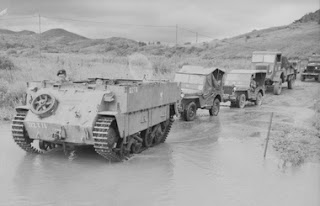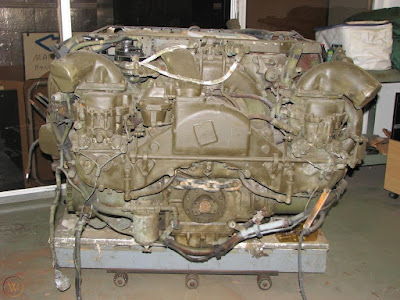(Because there weren't any big Christmas songs charting in December of 1950, although see below)
Whenever I put a hyphen after "Techno" in the titles to these appendices, I'm afraid that I will be too ambitious and ride of in all directions. But, c'mon. It's the Korean War. It's MASH and the war that Chuck Cunningham must have died in to traumatise his family so much they never even mentioned him again. It's a rich text!According to Wikipedia, John Clarence Woods was born in Wichita in 1911, enlisted in the US Navy the year he turned 18, went AWOL within months, was found too crazy for the navy, then worked as a general labourer until he was inducted into the army in August of 1943. Soon after he was allowed to volunteer as a hangman on the basis of a claim to have assisted at four hangings in Oklahoma and Texas that could have been disproved by even the slightest research. Sergeant Wood went on to botch at least 11 of the hangings he carried out for the Army (out of only 60 to 7) before he arrived in Nuremberg to add some Nazi war criminals to his list of the slowly strangulated. The Nuremberg trials! I have no words.But some anonymous US Army poets do (as reported by Janet Valentine):Hear the patter of running feet It's the old First Cav in full retreat They're moving on; they'll soon be gone They're haulin' ass, not savin' gas They'll soon be gone. Over on that hill there's a Russian tank A million Chinks are on my flank (Chorus) I'm movin' on, I'll soon be gone With my M-1 broke, it ain't no joke I'll soon be gone Million Chinks comin' through the pass Playin' burp-gun boogie all over my ass (Chorus) Standin' in a rice paddy up to my belly From then on, they called me "Smelly" (Chorus) I sung this song for the very last time Gonna get Korea off my mind I'm moving on; I'll soon be gone I done my time in the shit and slime I'm movin' on.("Well, if they go fast enough, maybe some of them will be home by Christmas" --General of the Army Douglas MacArthur, in unintentional irony)A Russian tank and a million "Chinese laundryman" to use the only slightly less racist language emanating from higher headquarters are on the flank, and it's time to bug out all the to the south bank of the Han. (The People's Volunteer Army deployed 6 corps comprising 18 understrength divisions against Eighth Army's 8 and two-thirds divisions, but whatever makes you feel better, man.)The particular ordeal of the Ch'ongch'on River was a run through a "gauntlet" of enemy harassing fire through a highway cut where the Japanese-built road leaves the valley of the Ch'ongch'on to climb and then descend a bench before arriving in the town of Kunu-ri. Lacking any anti-armour weapons or even much artillery, PVA blocking forces couldn't lay down anything more than a harassing fire, but over the length of the roadblock, casualties were heavy, and broken-down soft-skinned vehicles blocked passage for artillery and heavy engineering equipment that was eventually abandoned to the enemy. Not for the first or last time in the Korean War, US troops suffered heavily for lack of armoured personnel carriers to move infantry and engineering troops, which brings me to my final and actually significant bit of US Army incompetence:
Like the Arlington Cemetery tombstone says, General Christmas was born in 1895, reached the rank of Major-General, lost his wife in 1955, and died in 1962. The Arlington website is also kind enough to extract General Christmas' service biography:
"B.S. from Lafayette College in 1917. Commissioned in the Coast Artillery Corps in 1917. Served with the 60th Artillery at St. Mihiel and Argonne offensives in 1918.Graduated from Command and General Staff School in 1934 and the Army War College in 1935. Officer in charge of the Automotive Division at Aberdeen Proving Ground 1939-1941. Chief of the Tank and Combat Vehicle Division in the office of the Chief of Ordnance 1941-1942. Brigadier General in May 1942. Assistant Chief of the Tank-Automotive Center in Detroit 1942-1945. Major General in October 1943. Assistant to the Chief of Ordnance in 1945. Retired in January 1954. Decorations included the Distinguished Service Medal and Commendation Ribbon.
And that is all I've been able to find out about Major General Christmas since I encountered his name in the Ordnance Service Green Book lo these many years ago. The Green Books are usually pretty good about documenting the backgrounds of the general officers involved in the various volumes. Embarrassing figures like "Courthouse" John Lee, and figures that I would consider embarrassing like Brehon "Canol Road" Somervell get their pocket biographies. All General Christmas gets is a line in the text, and an index entry pointing back at the text.
So I guess I've given away the fact that I think General Christmas is embarrassing. I've also wondered for a very long time whether General Christmas is any relation to Dr. William Whitney Christmas (18665--1960). Dr. Christmas is behind perhaps the most famous fiasco in early American aviation history, the Christmas Bullet, and if I could finally drag that story into my blog, I would finally be one of the cool kids. Although maybe I don't want to considering how Dr. Christmas keeps being treated like a lovable eccentric of aviation when two test pilots died in his designs is a bit off-putting. Anyway, if there is some kind of connection, it is through a third Christmas, as John was still in school when Dr.Christmas somehow persuaded the US Army to loan him a prototype Liberty engine, the better to essentially murder pilots Cuthbert Mills and Allington Joyce Jolly, who really ought to be more prominent figures in the story of Dr. Christmas than they are.
So if there's a third Christmas at the back of this story, he's behind the Sherman tank (the cat's out ot the bag!) and the death of two test pilots. Could be, I don't know. Christmas is an unusual name, but it's not that unusual, and while John (and two subsequent Marine Corps generals named "Christmas") are from Pennsylvania, Dr. Christmas was a Southerner.
That dead end followed to its end, I'll move on to the machine at the heart of this discussion, with its own very short Time article:
The story of the M75 turns out to be similar to that of the many Patton tanks of the Korean War. The United States ended WWII with an improvised APC , the now almost-forgotten M39. which fought with distinction during the Battle of Imjin River. Deemed too lightly armoured, and lacking a roof, the M39 was replaced by the M75, which went through a leisurely development process from the end of war to 1951, followed by a frenzied rush to a manufacturable item, of w hich almost 1800 were produced in only two years before the army pivoted like whiplash to the M59, of which 6000 were produced between 1954 and 1960, when they were replaced in turn by the M113.
I'm not going to be the guy who defends an 18 ton, 2.85m tall APC. That's three times the weight and 115cm on the Oxford Carrier. Sure, it's nice to have a roof and I am sure that the American and Commonwealth troops running Korean gauntlets would have appreciated it, but that's a big penalty! What's more, the Saracen came in at 11t and 2.55m, and the MT-LB was even smaller.
Fortunately, Colonel David Crawford of the Detroit Tank Arsenal explained the logic of the order to Time magazine. First, all designs were to be standardised on a single "six-cylinder Continental air-cooled engine specially designed for the job." Second, the United States would be divided into five areas, "each designed to develop its own independent tank production system int he case of all-out mobilisation." Time gtoes on to explain that "Such decentralisation . . . will not only have stratetic advantages, but will distribute the econmic load of mobilisation evenly throughout the country, and help prevent migration of skilled labour to a few industrial centres." No new plants would be built, only existing plants converted. This would mean tha Detroit would not get much (more) tank work, as its existing plants weren't built heavily enough for tank materials. Unfortunately, plants elsewhere were somewhat at a premium and the Ordnance Corps greatly regretted the closure of a Continental Engines plant in Texas.
So it's nice that the Ordnance is getting into regional diversification, even if it has a lot to do with fear of the atom bomb. What about Continental Motors? There is unfortunately little to say. A major player in the Twenties, the Depression shrunk it down to a core motor business centred on a plant in Detroit. (The Texas plant is forgotten by modern motorhead historians.) The plant was taken over by Kaiser-Frazer, and Continental was taken over by Teledyne in 1969, leaving no corporate history in its wake. Continental was known for inline-opposed four cylinder engines for light aircraft; radial(!) air cooled engines for tanks, including the Sherman; an opposed six air-cooled engine for tanks in the postwar iera, including the AO895s that Colonel Crawford is talking about here; and later, an air-cooled "V" that was redeveloped into an air-cooled diesel.
Some nice hobbyist was kind enough to post a picture of the AOS-895-3 on the Internet, so here it is in all its gnarly glory. That's the 295hp (at 2660rpm) engine that goosed the M75 along on its merry way. And, yes, the same engine did go into the M41 Walker light tank, and probably some self-propelled guns that I can't be bothered to track down. The three Patton tanks, in contrast, got Continental's air-cooled V-12 AV1790, which was redeveloped into a diesel to go into the M60 (Patton)
. . . As did the 65 ton M-103, at which point I begin to wonder if I've slipped into some kind of parody universe, of wood-panel station wagons and Edsels, big, cozy cars with small engines.
One final moment of unburdening. It might be an ll-informed and amateur impression, but it nags at me: Air-cooled engines really don't seem like an appropriate choice for such compact, high power, high torque installations. The giant radial that defined the equally gigantic Sherman tank (and slightly less giant radial that went into the light tanks) has (have) traditionally been excused on the grounds that American industry had no other engines available for the job. The choice to persist with air-cooled engines, from a single supplier, at that, through the 1950s suggests that this story is wrong, and that this is actually a choice, that the Ordnance Service was specifying air-cooled designs.
Again, it's my impression, take it for what it is worth, that this was a mistake. The Russians weren't putting air-cooled engines in their AFVs. The British weren't putting air-cooled engines in their AFVs. The French didn't put an air-cooled engine into their scanty production of postwar AFVs. The Germans didn't. There's an argument for ai-cooling, that it makes for lighter and more reliable engines, and it will be heard even today with respect to WWII era aeroengines, but And it seems like the argument to the contrary was srong even before the whole postwar experience of the entire automobile industry demonstrated that this argument was, in fact, correct. At this late date, it looks like a bad idea, all-too strongly held. This whole chapter in the history of American industry and technology comes very close to sounding like a complete fiasco.
And I am left wondering about the House of Christmas.






No comments:
Post a Comment